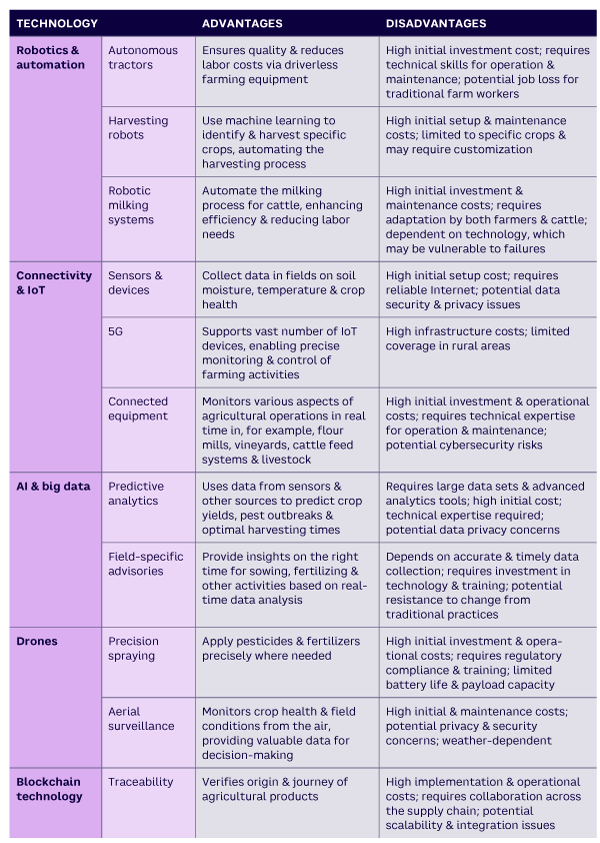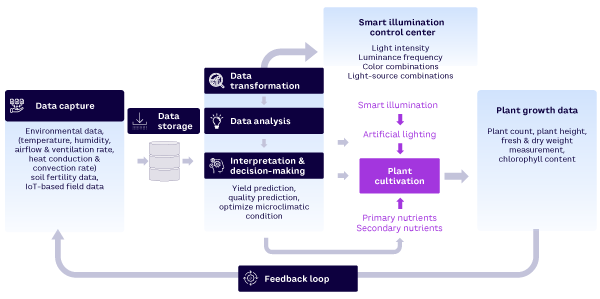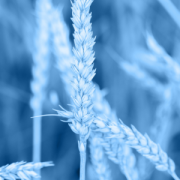AMPLIFY VOL. 37, NO. 6

The hydroponic forage market, which includes crops like barley, wheat, and maize, is experiencing significant growth. In 2023, the global hydroponics market was valued at US $5.2 billion. It’s expected to grow at a CAGR of 8.5%, reaching $10.8 billion by 2032.1 The hydroponic forage industry aims to provide year-round green forage for farm animals, reduce feed costs, improve production efficiency, increase profits, and create employment opportunities.2
Several companies in this sector are making substantial contributions to market growth with innovative, efficient hydroponic systems. For example, FodderTech offers systems that convert grains into green feed within seven days, greatly enhancing sustainability by providing a 98% reduction in water usage and a 99% reduction in land usage. The company says its systems can cut feed costs by up to 50% and reduce farmers’ carbon footprint by up to 70%.
Another prominent player, CropKing, sells hydroponic systems that produce up to 210 pounds of fresh barley fodder daily. Its designs focus on maximizing space efficiency and minimizing water usage. Similarly, HydroGreen offers automated systems that produce fresh, nutritious livestock feed year-round, helping reduce labor and other costs.
Hydroponic cultivation of forage crops such as barley, wheat, and maize supports sustainable agriculture goals by providing significant cost savings while enhancing animal nutrition.3 When AI and big data analytics are added, these systems not only boost production efficiency, they support the economic viability of small and medium-sized farms, making hydroponic farming an attractive option.4
This article explores the potential impacts of AI and big data analytics on hydroponic farming systems, focusing on the cultivation of barley, wheat, and maize as forage. Integrating AI into hydroponic systems can help farms optimize environmental controls, improve resource management, and enhance crop resilience.
Smart Farming & Sustainable Agriculture
Recent advances in AI and big data analytics have led to a new concept called “smart farming.”5,6 This concept, also known as “precision agriculture” or “digital farming,” refers to the use of advanced technologies and data-driven approaches to improve agricultural productivity, efficiency, and sustainability. Specifically, it involves integrating modern technologies into traditional farming practices to monitor, automate, and optimize agricultural operations.7 Table 1 describes the key farming technologies involved and their value to the smartness objective.

As Table 1 shows, advanced farming methods use technologies like AI, GPS (Global Positioning System), Internet of Things (IoT), satellite imagery, and data analytics to optimize crop management.8 These technologies improve productivity, resource efficiency, and environmental sustainability by providing precise information for managing inputs like water, fertilizers, and pesticides.9 They can also reduce costs, enhance crop yields, and minimize environmental impact, but they require a significant initial investment and strong technical and data management skills.10
In essence, big data and AI can integrate the social, environmental, and economic sustainability components of farming. This is crucial for realizing a holistic approach to sustainable agriculture. Social sustainability enhances farming and rural communities by developing shorter supply chains, fostering community involvement, and promoting youth development. Environmental sustainability focuses on mitigating carbon footprints, minimizing food waste, and enhancing food quality and security, primarily through lifecycle assessments and resource-recovery practices. Economic sustainability aims to reduce overall supply chain costs, boost productivity, and ensure long-term profitability by adopting strategies like short supply chains and the promotion of local food products.
Together, these sustainability components can lead to robust, resilient agriculture that not only supports economic growth but also protects the environment and enhances social well-being.
The Data Value Chain
AI and big data analytics can optimize hydroponic systems for producing fodder crops like barley, wheat, and maize by focusing on light conditions, automation, and environmental controls.11,12 AI has been shown to significantly improve water efficiency, plant growth, and yield consistency through smart automation, resulting in long-term economic viability, highly nutritional fodder, and improved environmental sustainability.13
AI and big data analytics can also accelerate the development of climate-resilient crops. By combining genomic, phenomic, and environmental data, AI can enhance predictive accuracy and decision-making in breeding programs to enhance climate resilience.14
There are six stages in the data value chain: data capture, data storage, data transformation, data analysis, interpretation/decision-making, and feedback:
-
Data capture. Vast amounts of data are collected from various sources, including environmental sensors, historical crop data, and market trends.
-
Data storage. The data is stored in a central database for further analysis. This stage involves storing and managing large-scale data sets while ensuring data reliability and availability.
-
Data transformation. The collected data undergoes processing and analysis using advanced AI algorithms. This step involves transforming and cleaning the raw data to ensure accuracy and relevance. The processed data is then analyzed to identify patterns, trends, and correlations that can inform decision-making.
-
Data analysis. The insights gained from the data analysis are fed into a decision-making system. This system provides actionable recommendations for optimizing hydroponic farming practices, such as adjusting nutrient levels, controlling environmental conditions, and predicting luminance frequency.
-
Interpretation and decision-making. The recommendations are implemented in the hydroponic systems. Continuous monitoring of the environment and crop health is maintained through sensors and IoT devices, ensuring real-time feedback and adjustments. The outcomes of the implemented strategies are evaluated to measure improvements in crop yield, resource efficiency, and overall sustainability. This evaluation helps refine the AI models and enhance decision-making processes.
-
Feedback loop. Continuous feedback ensures that evaluated outcomes are fed back into the data collection and analysis system, creating a cycle of improvement and optimization.
Figure 1 shows how AI and big data analytics can improve hydroponic cultivation. The integration of AI and big data analytics into hydroponic cultivation enhances the efficiency and productivity of forage crops and contributes to sustainable farming practices by optimizing resource use and reducing environmental impact.

Conclusion
The integration of AI and big data analytics into hydroponic cultivation of forage crops like barley, wheat, and maize is revolutionizing the agricultural landscape. This approach significantly enhances resource efficiency, crop resilience, and production sustainability. As the hydroponics market grows, with projections to reach $10.8 billion by 2032, these advanced technologies will play a critical role in addressing global food security challenges and environmental sustainability. Leading companies are driving this transformation by developing innovative systems that optimize water and nutrient usage, reduce labor costs, and ensure year-round production of high-quality forage.
AI and big data analytics contribute to these advancements by enabling precise environmental controls, predictive analytics, and real-time decision-making, thus maximizing productivity and profitability for farmers. The six stages of the data value chain (data capture, data storage, data transformation, data analysis, interpretation, and feedback loop) demonstrate how AI can significantly improve the efficiency and sustainability of hydroponic farming. This includes:
-
Improved resource management. AI-driven models optimize water and nutrient usage, reducing waste and improving crop yields.
-
Enhanced crop resilience. The ability to predict and mitigate issues like nutrient deficiencies and pest infestations helps maintain healthy crop growth and improves overall resilience.
-
Scalability. AI models can be scaled to larger hydroponic systems, making them applicable to both small-scale and commercial farming operations.
The potential of integrated systems extends beyond immediate economic benefits, promising a sustainable, resilient agricultural practice capable of adapting to climate change, conserving water, and minimizing environmental impacts. By fostering collaboration among researchers, farmers, and policymakers, we can fully harness the capabilities of these technologies to create a more sustainable and secure food production system for the future.
The adoption of AI and big data analytics by hydroponic farmers improves the efficiency and output of forage crops and paves the way for a sustainable agricultural future, addressing the pressing needs of our growing population and changing climate.
References
1 “Hydroponics Market Size, Share & Trends Analysis Report by Type, by Crop Type (Tomatoes, Lettuce, Peppers, Cucumbers, Herbs, and Others), by Crop Area, by Region, and Segment Forecasts, 2024–2030.” Grand View Research, accessed June 2024.
2 Ghasemi-Mobtaker, Hassan, et al. “A New Method for Green Forage Production: Energy Use Efficiency and Environmental Sustainability.” Journal of Cleaner Production, Vol. 363, August 2022.
3 Rajendran, Sasireka, et al. “Hydroponics: Exploring Innovative Sustainable Technologies and Applications Across Crop Production, with Emphasis on Potato Mini-Tuber Cultivation.” Heliyon, Vol. 10, No. 5, March 2024.
4 Grand View Research (see 1).
5 Abbasi, Rabiya, Pablo Martinez, and Rafiq Ahmad. “The Digitization of Agricultural Industry — A Systematic Literature Review on Agriculture 4.0.” Smart Agricultural Technology, Vol. 2, December 2022.
6 Rajendran et al. (see 3).
7 Rajendran et al. (see 3).
8 Harfouche, Antoine L., et al. “Accelerating Climate Resilient Plant Breeding by Applying Next-Generation Artificial Intelligence.” Trends in Biotechnology, Vol. 37, No. 11, November 2019.
9 Rajendran et al. (see 3).
10 Abbasi et al. (see 5).
11 Abbasi et al. (see 5).
12 Rajendran et al. (see 3).
13 Harfouche et al. (see 8).
14 Harfouche et al. (see 8).



